BlackBerry Torch 9800 Review: Keeping RIM's Flame Alive
by Brian Klug on September 1, 2010 7:00 AM EST- Posted in
- Smartphones
- Torch
- BlackBerry
- Mobile
Display Quality
So, SurePress is finally gone; it turns out you don’t need a reassuring click to successfully interact with a touchscreen. In its place is a capacitive multitouch display that’s mostly old hat for Android (post 2.1) and iDevice users alike. It’s nice to see that RIM was able to finally admit it was wrong about SurePress, even if there was never an outright admission. The Torch is admission of guilt enough, I suppose.
The touchscreen interaction on the Torch is actually top notch and responsive. I’ll get into browsing in a bit, but I found that multitouch gestures like pinch to zoom and flicking work and are recognized just like they should be. Part of making touch work is keeping the UI speedy and completely responsive, so that gestures and interaction take place fast enough to be believable. Luckily the Torch touchscreen always tracks properly and feels responsive.
|
Left: iPhone 4, Right: BlackBerry Torch (same size crops)
|
||||
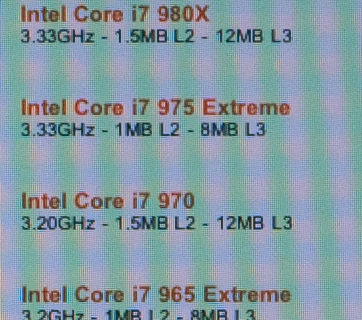 |
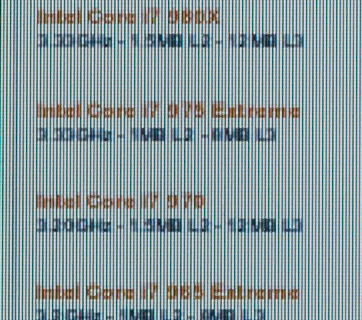 |
|||
Of course, the downside to the Torch’s screen is relatively low dot pitch, at 188 ppi. Bear in mind, however, that until the iPhone 4 swung around with its 330 ppi screen, the 3GS’ 165 ppi screen was generally considered good enough by many.
I made the move from a 285 ppi Touch Pro to the iPhone 3GS, and it took weeks to get over how downgraded that screen felt. Similarly, the larger 4” devices are creeping close to looking grainy as well, with the EVO 4G and Droid X sporting 217 and 228 ppi screens, respectively. There’s a fair amount of personal taste involved for whether physical size or dot pitch is most important.
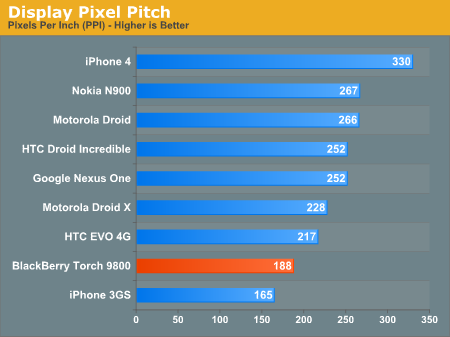
Higher dot pitch screens undeniably look more attractive in person, and admittedly the Torch is behind the curve in this regard, but the fidelity of the display is by no means disappointing enough that it should dissuade potential customers that are already BlackBerry owners. It's disappointing for sure that the Torch doesn't have something Retina Display level resolution sure, but it isn't a showstopper. That said, if you already do have a higher dot pitch screen, you’ll feel the same amount of distaste I did switching from a VGA Touch Pro to a QVGA iPhone 3GS over a year ago.

Left to right: Torch, iPhone 4, HTC EVO (click for full resolution)
You can really see the difference when comparing small text on webpages, and it’s especially dramatic when compared to the iPhone 4.
The Torch’s screen is one of the most readable outside that I’ve encountered in a while, with text and webpages being easy to make out even in intense daylight. Alongside the iPhone 4, the difference is pretty immediate, especially in how good white appears on the Torch compared to the iPhone 4.
The BlackBerry Torch 9800 is one of the most readable phones outside as I noted, and the reason is no doubt partially due to the exceptionally bright display - it's like a torch. Ha, ha, erm... Seriously it's the brightest I've measured:

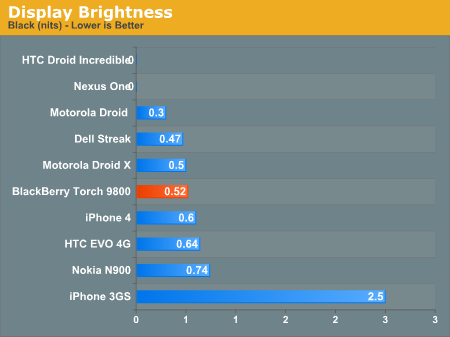
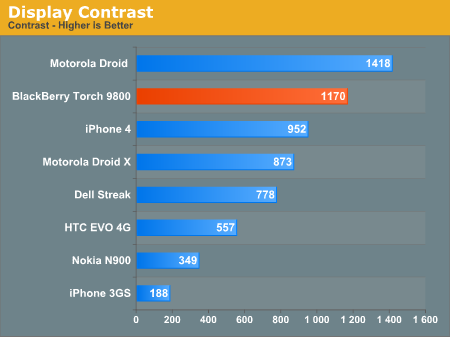
Contrast is quite good on the Torch but can't quite best the first Motorola Droid's IPS display, unsurprisingly. Of course, the HTC Incredible and Nexus One AMOLED displays lead here technically since their black brightness levels are literally 0 nits.
Viewing angles are good but not perfect on the Torch, especially compared side by side with the iPhone 4, though I never was wanting for better viewing angles during regular use. Full comparison gallery is below in full resolution.


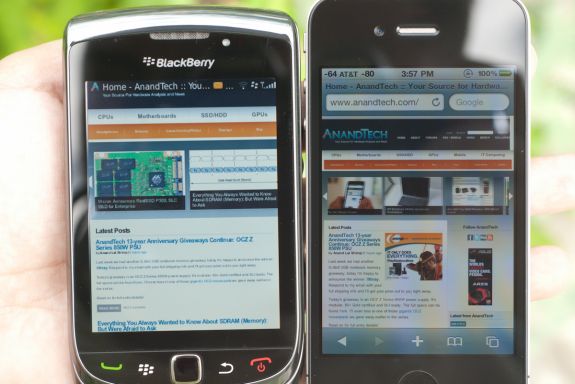














41 Comments
View All Comments
Kamen75 - Wednesday, September 1, 2010 - link
Rim needs two different BB lines to meet the needs of the two different types of customers they are selling to. They should have a BlackBerry Professional version of there os for corporate clients and then a "fun" version to sell to the average consumer. These two os's only need differ on a few security points and each gets a different ui, one to look business like and one to look flashy and bright. Underneath they would be the same os and run the same apps. Their current middle of the road, one size fits all approach is turning all customers away.Add in some decent hardware and you would have a competitive BB again. Two year old hardware specs impress nobody.
Zensen - Thursday, September 2, 2010 - link
that's what themes are for...RIM just needs to work on better tools for developers since what they've managed to do on the business level is second to none and I feel the overall improvement of OS 6 has done just enough to grab enough of the spotlight to be fresh yet familiar without being burdened by the lower specs that have dogged it since the its release.
There are still quirks in the OS 6 model that needs addressing such as in the social feeds but nothing that can't be solved via updates and UI changes. OS 6 has thrown away utilitarian menus and brought it up to speed with the other Operating systems. It hasn't leaped over like a triple axel but it's more like a combination of moves that will culminate in a much more successful Blackberry phone in the eyes of the average consumer, hopefully dispelling some of the noise that RIM can't do a touchscreen phone to save themselves.
I'm glad anandtech have finally covered this phone. Good or bad you can rely on these guys for great technical review without putting in ridiculous remarks or bias towards a product that reviews like engadget have seemingly perfected.
zorxd - Wednesday, September 1, 2010 - link
I am disapointed that Acanac fell into the Apple marketing trap which is PPI. Who cares about PPI? Do you really think that it's better to have a 1" 320x480 display than a 4" 480x800? The first one have higher PPI.Apple started to talk about PPI (even before pixel count) when they realized that the competition was going with larger displays. Larger display, with the same resolution, means lower PPI, even if it's better.
What looks sharp is not PPI. It's pixel count. Just hold your 4" 480x800 farther away if you think that pixels are too big. A 1x1 pixel 1000000000000 PPI display is useless.
So please, stop making graphs about the useless metric which is PPI and start comparing what we actually care about: brightness, size, resolution, etc.
raulr - Wednesday, September 1, 2010 - link
Have you actually looked at the iPhone 4 display. It really is quite fantastic. And especially since this review is about the Torch, your display size argument is pointless since the torch is both physically smaller and lower resolution. The point they were making is that the Torch display, while not bad, really doesn't stack up with the current generation of devices.zorxd - Wednesday, September 1, 2010 - link
The iPhone 4 display is one of the best, I agree. Why? Because it has the highest resolution. The PPI have nothing to do with that. The iPhone display would be even better if it was larger, even if that would mean lower PPI.Of course, the phone would probably get larger too, which is a downside.
What I mean is that the highest PPI is never, or at least should never be an priority for any consumer.
The iPhone display would suck if it was 2" instead of 3.5".
MacTheSpoon - Wednesday, September 1, 2010 - link
He is right, though -- nobody cared about PPI before Apple started their marketing. Now suddenly it's the standard by which screens are judged. Weird.I have looked at the iPhone4 screen and while it's nice, it's nowhere near as nice as all the marketing and buzz make it out to be. I cannot read all that sharp yet incredibly tiny web page text without a magnifying glass. I'd say it's about 20% as nice as all the hype. A large screen that lets you see more of your web pages in an actually readable way is certainly nice, too, probably a little bit nicer -- and yet for some reason the iPhone4 gets a pass on this readability issue from all the reviewers, just as Apple hoped. Honestly, having seen the iPhone4 screen, its main benefit is in browsing photos, which look really smooth, but who uses their phone mainly for browsing photos? Not that many people, I'm sure.
I believe that the whole PPI thing came about because Steve Jobs realized his 320x480 screen was getting long in the tooth compared to other phones but a) didn't want to change the dimensions of the current iPhone and b) wanted to make the existing iPhone layout and apps easy to port by simply doubling the screen resolution. So he pushed the PPI angle hard and zombie reviewers got in line.
bplewis24 - Wednesday, September 1, 2010 - link
Great post.Brandon
synaesthetic - Friday, September 3, 2010 - link
Lots of people care about PPI, just not so much on smartphones.I hope Apple's obsession with PPI and the Retina Display pushes the trend into *laptops,* so I can finally stop seeing 15.6" laptops with 1366x768 horrible LCDs.
Jabroni444 - Wednesday, September 1, 2010 - link
I'm confused by conflicting statements in this review. Half way through the conclusion he says, "I’ve described the Torch as anywhere from a quarter to a half generation behind - I think that’s the best way to describe performance." But, the last sentence is, "The Torch is what RIM should have launched years ago in their stead."Combined with the fact that the Torch both statistically and measured performance wise is no better than the iPhone 3GS or other last-gen phones I don't get the quarter to half generation behind comment.
I'm not sure whether even hardcore RIM users are going to be able to accept weak attempt at getting up-to-date.
tech6 - Wednesday, September 1, 2010 - link
A very balanced review. This device isn't for techno snobs or people who like to show off apps - it's still a business communication device. While anecdotal, I know a number of BB users which looked at Apple and Android but decided to go with the Torch instead. Without exception they are happy as it gives them the new functionality they wanted but without leaving the BB strengths and advantages behind.